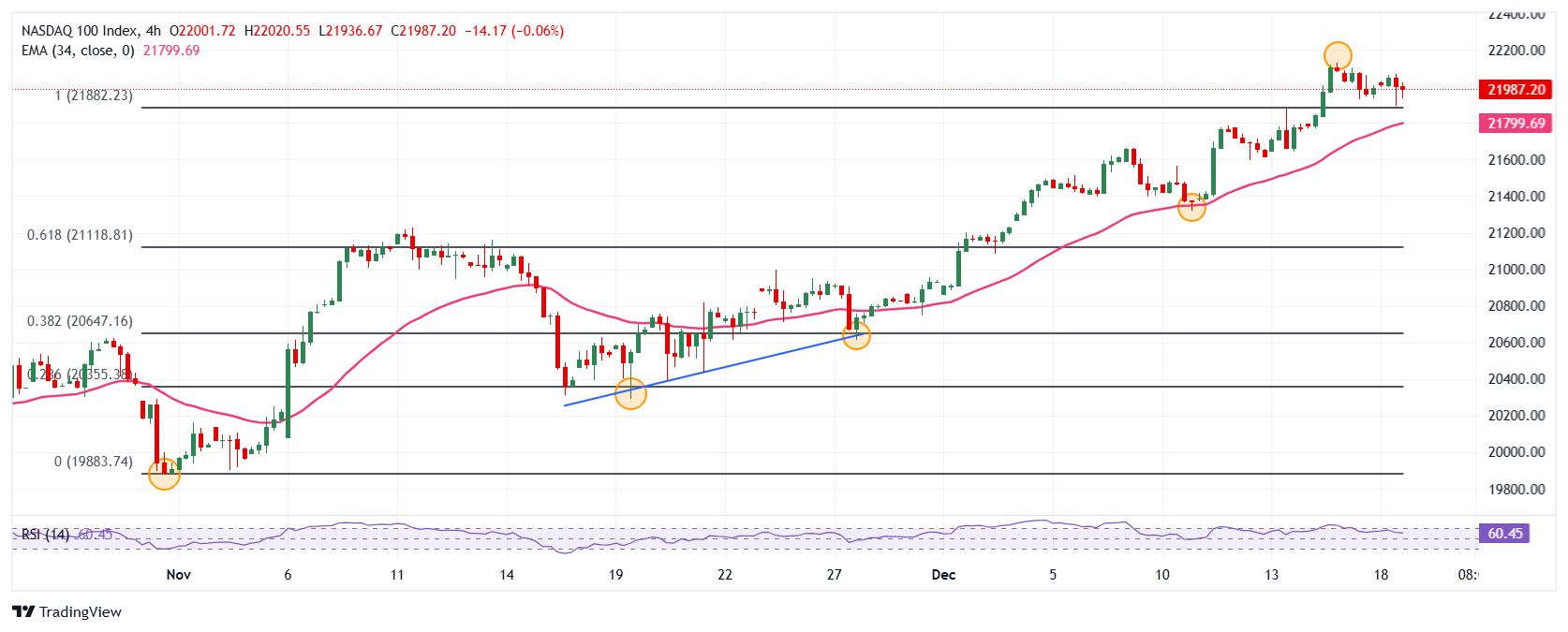- The Dow Jones rises 0.37% today.
- The Nasdaq 100 gains 0.05% on the day.
- The S&P 500 rises 0.29% in trading on Wednesday.
The Dow Jones increased 0.37%, trading at 43,560 at the time of writing, ending a streak of nine consecutive sessions in negative territory.
The Dow Jones Industrial Average began trading at 43,517, while the Nasdaq 100 technology index opened at 22,022. The S&P 500 began trading at 6,059, ahead of the Fed’s interest rate decision.
Nvidia and UnitedHealth push the Dow Jones into positive territory
The Dow Jones Industrial Average is trading at the time of writing above 43.591, gaining 0.37% daily, reaching two-day highs at 43.690.
Nvidia (NVDA) shares are up 3.66% today, hitting December 13 highs of $136.70. In the same vein, UnitedHealth (UNH) shares gained 2.73% on the day, visiting two-session highs at $503.79. Both companies partially recover the losses suffered the previous day, where the Dow Jones visited lows not seen since November 21 at 43,325.
GlobalFoundries and ASML push Nasdaq 100 into profit zone
The Nasdaq 100 technology index rises marginally by 0.05%, currently trading above 21,998, consolidating within the range of the previous session.
GlobalFoundires (GFS) shares rise 2.60%, hitting highs not seen since December 9 at $45.47. In the same vein, ASM Holdings (ASM) shares gained 2.16%, reaching highs of more than two months at $157.19. The Nasdaq 100 remains timid amid nervousness over the Fed’s interest rate decision, to be published today close to market close.
The S&P 500 trades with gains ahead of the Fed’s decision
The S&P 500 index gains 0.29% on the day, trading at the time of writing above 6,065, reaching two-day highs at 6,069.
U.S. building permits rose to 1.505 million in November, beating estimates of 1.43 million. On the other hand, housing starts stood at 1,289 million units, today below the 1.34 million projected by analysts. Investors’ focus will be on the Federal Reserve’s interest rate decision today, with a 25 basis point cut expected to 4.50% from 4.75%.
Technical analysis of the Nasdaq 100
The Nasdaq 100 does not go down in a short-term resistance at 22,131, given by the all-time high reached on December 16. The closest support is found at 21,319, the low of December 10, supported by the 34-period exponential moving average. The next key support level is at 20,293, the pivot point of November 19.
Nasdaq 100 4-hour chart

Dow Jones FAQs
The Dow Jones Industrial Average, one of the world’s oldest stock indices, is made up of the 30 most traded securities in the United States. The index is weighted by price rather than capitalization. It is calculated by adding the prices of the securities that comprise it and dividing them by a factor, currently 0.152. The index was founded by Charles Dow, also founder of the Wall Street Journal. In recent years it has been criticized for not being sufficiently representative, since it only follows 30 companies, unlike broader indices such as the S& P 500.
There are many factors that drive the Dow Jones Industrial Average (DJIA). The main one is the aggregate performance of its component companies, revealed in quarterly corporate earnings reports. US and global macroeconomic data also contribute, influencing investor sentiment. The level of interest rates, set by the Federal Reserve (Fed), also influences the DJIA, as it affects the cost of credit, on which many companies largely depend. Therefore, inflation can be a determining factor, as well as other parameters that influence the decisions of the Federal Reserve.
The Dow Theory is a method for identifying the main trend of the stock market developed by Charles Dow. A key step is to compare the direction of the Dow Jones Industrial Average (DJIA) and the Dow Jones Transportation Average (DJTA) and only follow trends where both are moving in the same direction. Volume is a confirmation criterion. The theory uses elements of maximum and minimum analysis. The Dow theory proposes three phases of the trend: accumulation, when the smart money begins to buy or sell; public participation, when the general public joins the trend; and distribution, when the smart money abandons the trend.
There are several ways to trade the DJIA. One of them is to use ETFs that allow investors to trade the DJIA as a single security, instead of having to buy shares of the 30 companies that comprise it. A prominent example is the SPDR Dow Jones Industrial Average ETF (DIA). Futures contracts on the DJIA allow traders to speculate on the future value of the index, and options provide the right, but not the obligation, to buy or sell the index at a predetermined price in the future. Mutual funds allow investors to purchase a portion of a diversified portfolio of DJIA securities, providing exposure to the global index.
Source: Fx Street
I am Joshua Winder, a senior-level journalist and editor at World Stock Market. I specialize in covering news related to the stock market and economic trends. With more than 8 years of experience in this field, I have become an expert in financial reporting.







